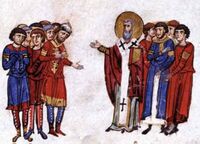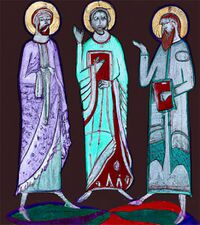Fourth Council of Constantinople (Eastern Orthodox)
St. Photios has the unusual honour of having two church councils called to establish his status. In one council held in 869-870 saw his removal from the office of Patriarch of Constantinople was confirmed by Byzantine emperor Basil I. In a second held 879-880 which is known as Fourth Council of Constantinople (Eastern Orthodox) Photios was confirmed in the same office by the same emperor. What was going on?
Today Photios has been granted the honour of being called St. Photios but only in the Eastern Orthodox Church. To Roman Catholics he was the Patriarch of Constantinople who held a conference that denounced a pope as a bloody heretic.
Background[edit]
Since 858 there had been a long running dispute over who was the rightful Patriarch of Constantinople between the supporters of Ignatios and Photios. Ignatios had been deposed in 858 in a battle for control of the Byzantine emperor Michael III between his mother Theodora and her brother Bardas. Theodora had lost and got sent to a convent. Ignatios replacement was Photios, a worldy wise philosoher who had a book collection to rival that of an emperor, let alone anyone in Western Europe included the largely ruined city of Rome of the popes. Once it had been confirmed that Ignatios had been sacked, Photios was very fast tracked from going as a layman on a Monday to a full blown patriarch by the Sunday. Naturally enough other priests and bishops complained about Photios's rapid promotion.
They were backed up their complaints by Pope Nicholas I who demanded Ignatios be restored and when Photios ignored that, formerly deposed his rival. Since the pope had no powers to have anyone arrested in Constantinople and with emperor Michael behind Photios this was ignored.
Photian Schism[edit]
Between 863 to 867 Catholic and Orthodox churches were officially in schism from each other. In practice this meant they couldn't conduct a religious service for each other or exchange Christmas cards either. Photios took the position that the Papacy were already in theological error by trying to add 'innovations' to the Christian creed and that a pope had no right to kick another patriarch even if provoked in an argument. In 867 Photios managed to get the other patriarchs in Alexandria, Antioch and Jerusalem to call Rome out and declare Pope Nicholas a heretic. This message was delivered to Rome but by then Nicholas had died
The Other Council[edit]
Photios's position dramatically changed when emperor Michael III was assassinated by his successor Basil I. This barely literate stable hand had climbed to the top of the Byzantine greasy pole to become the most powerful Christian emperor. Perhaps because of earlier slights from Photios when Basil was still polishing saddles, the new emperor had Photios removed from office and restored Ignatios. To make this look more official, Basil and Pope Adrian II (successor to Pope Nicholas) had called a church council to confirm the changes. A somewhat lack lustre and at times sparsely attended meeting was arranged in 869. This council is now called the Fourth Council of Constantinople (Catholic Church). Besides tidying up some issues about what made a religious icon more important than another and what colour vestments to wear at weddings, the council's decisions had been accepted by Pope Adrian II and emperor Basil. Photios could have gone into exile and ended up on a cold, damp rock in the Bosphoros but he instead got a job as tutor for the children of Basil.
Return of an exile[edit]
In 877 Patriarch Ignatios died. He was granted sainthood status in both the Catholic and Orthodox churches, one of the last time these two organisations would agree on an issue of sanctification. Emperor Basil had no hesitation in replacing Ignatios with Photios. Why? We don't know. Perhaps he liked Photios's teaching methods. In any case Basil decided to call another church council. This one would confirm that Photios was now Patriarch and that everyone was to officially forget about the earlier council ten years earlier and during the Photian Schism. In a rare example of Christian charity, this was agreed.
Invites were sent out and nearly 400 bishops of various sizes and observance of Christian values attended the meeting. Photios's position was confirmed by cries of total consent. The Papacy sent a full delegation too so that it seemed the old alliance of from the days of the Council of Chalcedon had been restored. It had gone through great strains during the two eras of Iconoclasm. There was just that wee theological issue to discuss about the Holy Spirit. Did Rome agree with Constantinople or were they following a distinctive Spanish-French position?
Back to an old dispute[edit]
As seems obvious old religious disputes tend toe fester rather than heal in Christianity. Take for example the Filioque question. The Greek East said the Holy Spirit was passed to Jesus who then send it to Christians to act on. The Latin West said the Holy Spirit could come from God or Jesus. The Popes hadn't made this a doctrinal fundamental.
At this stage the Papacy had made no firm committment to either interpretation of how trinity worked. They seemed to be an 'either and or' approach whereas the Orthodox were adamant that their way was the true way. To talk about the Holy Spirit coming from two directions was wrong.
This lead to the Filioque position receiving the full blast of Photios's theological opposition to it. The representatives of Pope John VIII who had become pontiff in 872 on the death of Pope Adrian II appeared to agree with Photios's anti-filioque position. They certainly didn't produce a minority report. So the council condemned anyone who backed filioque as a dirty schismatic.
Booted out again[edit]
The council finished its work in 880. Patriarch Photios had appeared to have triumphed. The official church position on the Holy Spirit had appeared to be resolved in what was presumed to be the Orthodox position. The Papacy had gone along with this, yet refused to condemn other Western Christian churches who had included the filioque option in their liturgy. This was more to do with politics than religion. The Papacy was entering a very weak phase in its history where for the next nearly 200 years popes would be deposed, murdered and father children in contradiction with their religious vows. The seas around Italy were full of pirates, many from Muslim Sicily and North Africa. This was no time to make enemies.
In comparison the Orthodox church under Photios appeared to be all powerful. During this time a tussle with Rome over who was going to Christianise Bulgaria had been won by the Orthodox church. However Photios eventually fell because some of his ex-students wanted him sacked. This happened to include emperor Basil's sons Leo VI and his brother Stephanos. In 886 Basil died. Leo's first act was to get Photios sacked for a second time and then place his own brother Stephanos as Patriarch of Constantinople. Leo accused Photios of 'treason' but in the end settled for his former teacher's permanent banishment to a very draughty monastery. He died in 893 aged about 80.
So why are there two councils with the same number?[edit]
Because the 4th Council of Constantinople between 869-870 condemned Photios this is not seen as canonical by the Orthodox church. In a similar fashion the other 4th Council of Constantinople from 879-880 is regarded as a 'bad show' by Catholics as it condemned filioque as heresy when that was later adopted as official Catholic doctrine by Rome in 1014.
There matters would rest until 1054.
See also[edit]
| Preceded by: Second Council of Nicaea |
Christian Councils 879-880 |
Succeeded by: Great Schism |




